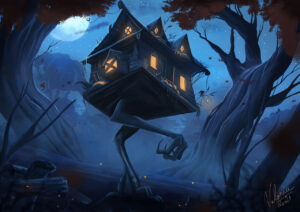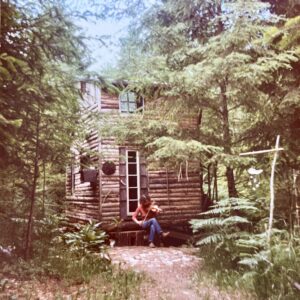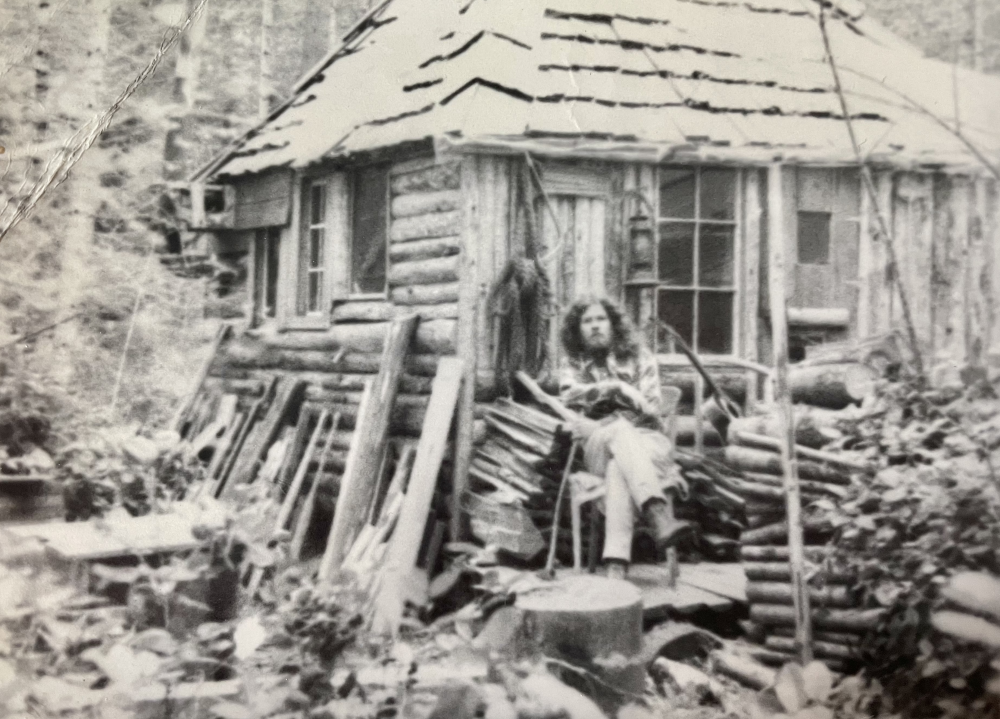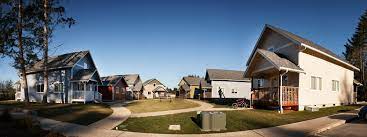HOUSEHOLDS
Life on a Hippie Farm
By Anna Schlecht
When I first came to Olympia in the mid-1970s, I was enchanted by stories of the early days of Evergreen when there was very little housing on campus and not much rental housing available in town. Apparently, many of the first students lived in tents and DIY cabins in the woods surrounding the campus. It all sounded enchanting and I decided that’s the life for me. Somehow I heard about IOCWAT Farm (In Our Community We Are Together), most likely one of the other residents who rolled through my check-out line at the downtown food co-op and told me there was an opening. Or perhaps I found a flier about the farm with a tear-off number to call. However it was that I found the farm, moving to this rural commune began my chapter of living off grid.
I can’t remember if there was any kind of application process. Most likely it was a simple interview with the owner, a widowed woman named Peg Wortman, although everyone called her Mingo.
“Tell me all about yourself!” she implored, with a huge smile across her face. Mingo was a remarkably good listener, a quality which was probably useful in figuring out who she did and didn’t want living on her farm. She had a magnificent mane of hair that doubled as an aura, almost sparkly with energy. During this first chat, she radiated interest in everything I told her about my life and why I came to Olympia. As I later got to know her better, I saw that she did most everything with the same level of sheer delight—meeting new people, tending to the farm, composing her thoughts on a typewriter. While she looked like someone who belonged in a middle-class house in a suburban cul-de-sac, her actions proved that she was right at home in a commune.

Her house looked conventional enough when I pulled up. But once inside the door, the house was filled with all the smells that clung to kitchens everywhere that hippies made food, apparently we all used the exact same spices from coast to coast.
After chatting a bit, Mingo took me on a tour of her farm, following a well beaten path that circled the main pasture. As we walked, she explained the origins of the acronym IOCWAT and what this rural community was all about. In short, this was a hippie farm. While there was a large garden, the real crops she grew were all kinds of crazy dwellings.
I found myself staring at Mingo as she talked, wondering how she ended up completely surrounded by hippies. Had there been an invasion? Did she contract with Evergreen to provide housing? As we walked along, she told me the story of each structure and all the amazing people who had lived there. Most of the residents either were or had been Evergreen students, and each of them seemed to be an artist of some sort—actors, musicians, painters or sculptors. At that point in time, most of them were involved in an Evergreen program called Chautauqua, one of Evergreen’s famous interdisciplinary courses that studied the history, politics and the folk practices of community-based performance art.
In between the tour stops, she explained that this was her family home, but since her husband had passed away and her oldest daughter was gone, she had created a new life. She and her younger three children lived in the main house surrounded by pastures and woods. From the house, you could see the barn and a few other outbuildings. And just beyond the tree line was the rest of her village.
Back to Baba Yaga?

To me, this was an otherworldly scene. I felt like I had been transported into the Eastern European folktales of my childhood. It would have been fitting to come around a corner to find Baba Yaga in her cottage on legs. While these fairytales had portrayed the deep forest as a mysterious and foreboding place, my adult eyes found Mingo’s woods to be a hushed wonderland, one with fairytale-like dwellings, hugged by dense underbrush and surrounded by moss covered trees. The dampness in the air seemed to be one of the many filters that kept out the air pollution that was so rife in the cities. It was astounding to think people were living in this forest, even more so that I would soon become one of them.
Each resident paid a very nominal rent, scaled according to the stage of completion of their structure. We could live in our respective dwellings as we found them, or residents could continue to build out the structures or other whimsical creations. My favorite such creation was an outhouse that had a roof and a window but no door or walls, something that offered amazing views but zero privacy and little protection from the weather.
The Agrarian Fraternity/Sorority Row
At the time, many students joked that these farms and rural households with acreage were Evergreen’s equivalent of an academic Greek system. Though instead of being known by their Greek letters, they had fanciful names like Calliope Farm, Millet House, and Nanny Noodles. Some of them were entirely conventional housing with creative outbuildings. Others were run-down farmhouses surrounded by all manner of structures.
My Tepee

My first accommodation at IOCWAT farm was a tepee, an indigenous dwelling originally from the tribes of the Great Plains. Hippies borrowed liberally from any culture, now understood to be co-optation by those of us who were not part of those cultures. Whoever put it up did a good job of stripping the bark from the poles and stretching the canvas across the frame. Still, my sad little tepee was dreadfully ill suited for a rainy climate, even after I modified it with a patio umbrella that I found at a junk store downtown.
My tepee was also infested with mice. Late at night, they would run laps around the inside periphery, competing in some kind of rodent rollerdrome. One night, one of them got entangled in my massively curly hair. After shrieking and shaking it loose, I pulled a wool hat down to my nose for protection. Unnerved by my unwanted roommates, I slept with that hat on every night thereafter.
On another fateful night, the central wood stove melted my sleeping bag, though fortunately never set it ablaze. This stove offered little protection from the elements, with the chill and humidity coming right through the canvas walls to infuse my dreams. Somehow I survived the winter.
We residents were invited to participate in caring for the livestock and gardens, which meant sharing the bounty of milk, eggs and vegetables. Mingo’s farm had one cow, occasional steers, several goats, and a huge garden. Every day, there were eggs to collect, weeds to pull, and a cow to milk.
There was one goat that had babies, and for the first time I experienced the way that baby goats climbed up everything. EVERYTHING. The sensation of tiny cloven hoofs scampering up my back was unforgettable. Sadly, the mama goat didn’t make it. One night she got into her feed and ate uncontrollably until her belly began to swell. That night I learned that one of the grim realities of farm life is that you sometimes must put an animal out of its misery. Her tortured bleating still rings in my ears.
I wrote home about all of my adventures, especially about how I learned to milk a cow named Mollie. I had the evening shift and each night all the farm cats would appear, hoping to get some milk. I never managed to squirt milk right into their mouths, but they seemed happy enough to lick it off their fur.
My letters home also shared tales of helping my neighbors build new homes out of logs straight from the woods. That required falling the trees, stripping the bark and taking some of the logs to get ripped into siding. I thought this was all a remarkable accomplishment, far more important than going to college.
My mother wrote back, only partly joking, saying, “This is just great. Our family leaves the back-breaking farm life in Europe, comes to the new world to start a new life, all for you to move back into the 1800s to live in a tent and milk a cow!”

Some of the cabins were conventional looking, one was shaped like an octagon, others had impossibly fanciful designs. So impossible in fact, that they remained incomplete with gaping holes barely covered by plastic sheeting. While I first thought I was surrounded by architectural geniuses as neighbors, I soon realized most of them were big on ambition but light on skills.
Building was fun, and finding materials for free or cheap was an exciting challenge. My new-found friends gave me the lowdown on where to find building materials, none of which involved conventional retail. Perhaps because many of them were artists, they insisted on drawing maps to help me find my way. Most of the maps featured long, windy roads between creative interpretations of things like “the water” characterized by waves filled with bizarre sea creatures. A central feature of all these maps was Spud and Elma’s Two-Mile House, apparently the center of the universe, portrayed as a roofed box with a beer mug inside and happy people whose overflowing hair spilled out of the windows.
Hunting & Gathering
My first hunting and gathering foray took me downtown to the waterfront, where an ancient pier was being demolished. In the near distance, I could hear seals barking in the water below and seagulls calling in the sky above. Very different from growing up near fresh water lakes. Looking around the pier, I found the head guy in charge and he told me, “Take all you can salvage in an hour for five bucks. Don’t fall in.”
That seemed fair, so I got to work with my borrowed crowbar and pulled up about 20 planks of the salt-cured two-by-eight tongue and groove decking. I was so proud of my stack, I didn’t realize that half the work was pulling it up, the other half was figuring out how to stack it on top of my car. My Rambler Classic must have been quite a sight driving slowly up the westside hill, with a precarious load of wood up top.
I was so proud to be one of the many people keen to find and reuse building materials, later known as “up-cyclers.” There were many of us who scoured the alleys, searching everywhere to find plywood, sinks, etc.—all free of charge. Our farm was one of several where the dwellings were constructed of twice-used, sometimes thrice-used building materials. This ethic was something I learned early on from parents of immigrant stock raised in the depression era.
Eventually, I got it home, cut and nailed down to expand my tepee platform. This was my one and only contribution to the built environment of the farm. As a light rain fell, I imagined how nice it would be to sit out there in sunny weather. After a few weeks, I realized that sunny weather was not likely to arrive for months. As the winter days got shorter, my nights alone in the tepee felt longer. I realized it was time to move.
A Cabin for One

Eventually, I was able to move into a vacant cabin, a simple structure with one main room and a pole ladder up to a sleeping loft. The siding was irregular slab rips from the sides of logs, pretty to look at but filled with gaps. Here too, I had plenty of mice for neighbors, always quite industrious at night. Fortunately, they stayed next to my food downstairs, and I stayed up in the loft. The interior was only warm and relatively dry while the wood stove was blazing, but as soon as the fire died down my cabin was just as cold and damp as sleeping outside.
My friends knew exactly what to give me to make it a home. Two bowling balls. “These are perfect for trail bowling!”
“Trail bowling?” I asked.
I had grown up in a harsh climate where bowling and drinking were the only pastimes in the dead of winter, but no one I knew has ever talked about “trail bowling.” Another friend suggested that they doubled as a kind of fitness equipment that was not yet a thing available on Amazon, which was also not yet a thing. “Think of them as Russian kettle bells!” Again, a new concept. But they did offer a great workout when swung slowly up and down. Parked near the front door of my cabin, these bowling balls became my garden décor.
One of the more unique aspects of living deep in the woods was the common practice of walking in the dark. When the moon was out, it was easy to discern the trail from the brush. On moonless nights, my feet had to remember the way. Somehow, that felt like a rite of passage, officially marking me as an outdoors woman.
As spring came, everyone’s spirits started to lift. Our parties went from being grim little gatherings in tiny, damp cabins by candlelight to open-air events lit by lanterns. The Chautauqua people knew how to party! The lack of electricity meant no canned music. Instead, they would each take turns entertaining us with songs, dances, and bizarre monologues. My best contribution was that of an enraptured spectator.
By fall, I decided it was time to move closer to town. Although I had loved living among artists, I knew I didn’t want to face another winter on the farm. While all of them were politically aware, none of them seemed to be political organizers and few of them were gay. I knew there were more of my people I still needed to find, so I moved on.
45 Years Later
I can’t imagine living in a rustic cabin in the woods now, the cold and damp would be hell for my arthritis. The lack of amenities would far outweigh the wonder of living intertwined with the trees. But what stays with me after all these decades later is the concept of communal living. The idea of living close enough for a strong sense of community yet distant enough to retain a sense of independence. And perhaps most importantly, the value of affordable housing for low-income people—communal housing brings down everyone’s cost of living.
Once I actually attended Evergreen, I learned about Catherine Bauer, the mother of “Modern Housing,” her term for housing as public infrastructure. Not unlike shared roads, shared schools, or shared parks, Bauer envisioned housing as a shared public good, affordable to low-income people while at the same time desirable by higher income people. This model thrived in Britain until the Thatcher Era, but sadly was thwarted here in the US.
During my time as the Olympia Housing Program manager, I encountered a form of the communal housing model in Quixote Village’s “tiny house” community and once again in the Habitat for Humanity’s cottage housing developments. Now at this phase of my life, forty-five years later, I find myself keen to envision elder housing. Ironically, the housing of my youth seems to be a good model for the housing I want as I age: cottage housing for older adults who are used to their autonomy but still need the safety of a community nearby. Shared affordable housing. Perhaps not so many trees and certainly with better lit walkways.

We encourage readers to use the form below to make comments and suggestions. Disclaimer
